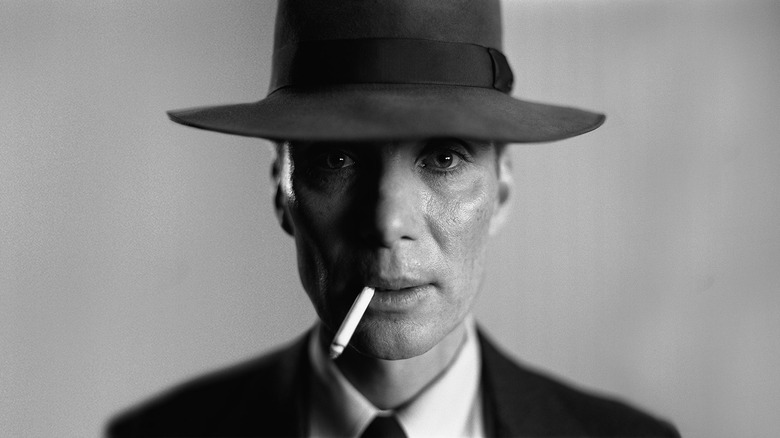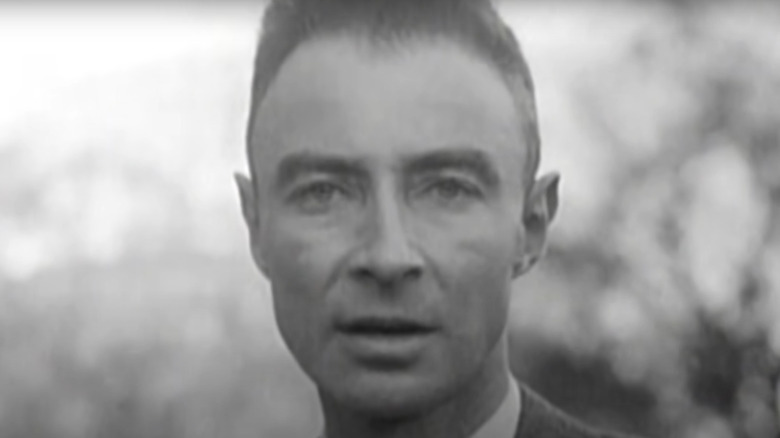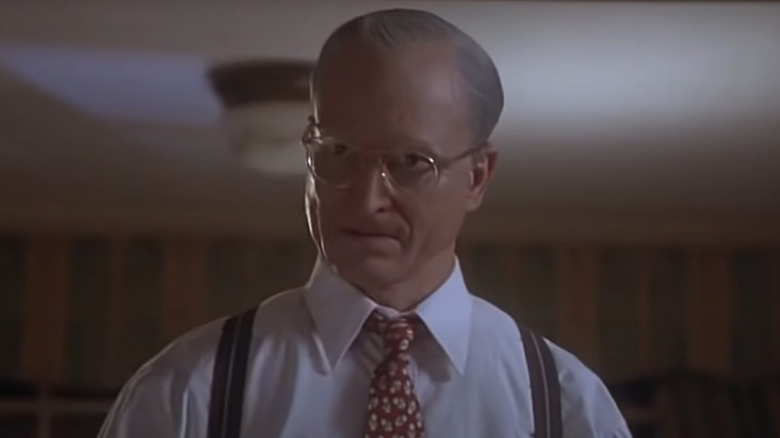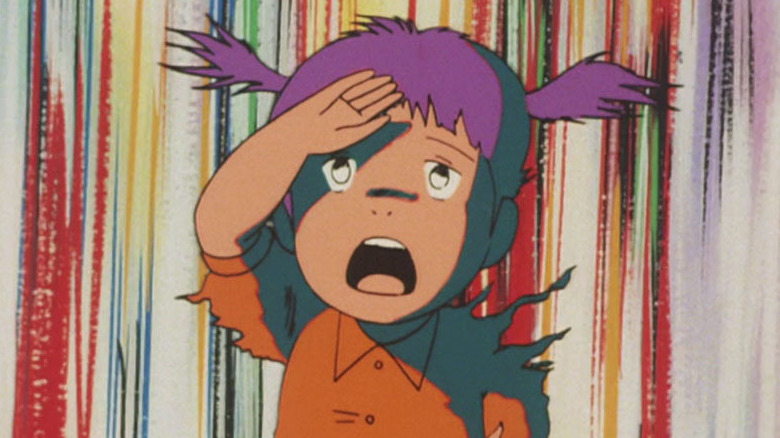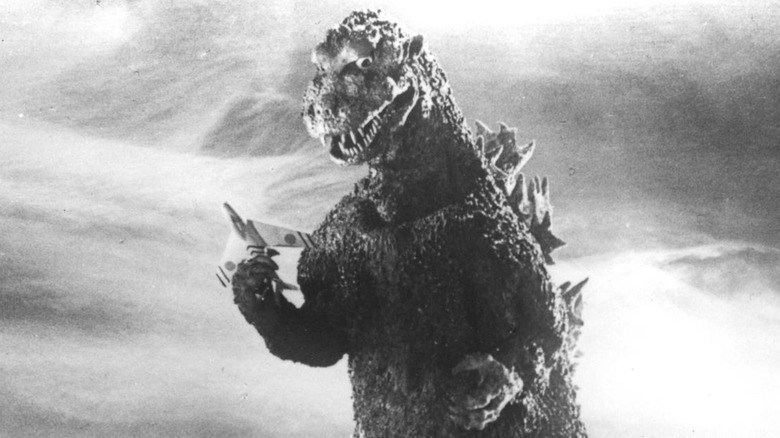What To Read And Watch To Prepare For Christopher Nolan's Oppenheimer
Christopher Nolan's last historical epic, "Dunkirk," made a massive splash in both the international box office and during its awards run. With eight Academy Award nominations and three wins alongside over $500M on its theatrical run, Nolan's a force to be reckoned with when he turns his filmmaking talents towards the war drama genre. When Nolan announced that his next film will be the wartime biopic "Oppenheimer," based on the life of atomic bomb inventor J. Robert Oppenheimer, it immediately became one of the filmmaker's most exciting upcoming projects.
Of course, the Manhattan Project (the research and military undertaking that produced the United States' nuclear bomb) and Oppenheimer both have complex legacies. While some regard the scientist as hero, his pivotal role in designing one of the most dangerous weapons the world has ever known has its fair share of critics. Before "Oppenheimer" graces theaters, here are some key literature and media to get a greater window into both the man and the complexity around the atomic bomb and its tragic and devastating legacy.
"Oppenheimer" opens July 21, 2023.
J. Robert Oppenheimer and his role developing the atomic bomb
Oppenheimer joined the war effort following the fall of France in 1940, was appointed project leader in 1942, and the first atomic bomb was tested on July 15, 1945. A month later in August of 1945 came the fateful dropping of atomic bombs on Hiroshima and Nagasaki, heavily contributing towards the surrender of the Japanese military. Oppenheimer's subsequent regret over his role in such a destructive creation came to define the rest of his career. While he continued to see Allied development of the atomic bomb as pivotal to winning the war, he unequivocally regretted its deadly effects, feared its further consequences, and wished the U.S. government had prevented or reduced the death toll by making known the bomb's catastrophic potential. Oppenheimer spent the rest of his career advocating for responsible controls over nuclear weapons and their further development.
To get a wider window into Oppenheimer's life, the key text that inspired Nolan's "Oppenheimer" is the Pulitzer winning "American Prometheus: The Triumph and Tragedy of J. Robert Oppenheimer" by Kai Bird and Martin J. Sherwin. It's also useful to check out "Oppenheimer and the Manhattan Project," a collection of essays by experts edited by Cynthia C. Kelly that explore different aspects of his life and his role in the Manhattan Project. There are also a number of collections of Oppenheimer's speeches and writings on science and scientific understanding, like "Science and the Common Understanding" (1954) and "The Open Mind" (1955). If you want to explore his life further still, in 1980 the BBC released an award-winning TV serial called "Oppenheimer" (with Sam Waterston in the title role). You can also check out a documentary exploration in the Oscar-nominated 1980 doc "Oppenheimer," and if the theater is more your speed Thomas Morton-Smith wrote a well-reviewed play "Oppenheimer" in 2015. You'll be more than caught up on the intricacies of a complex historical figure.
The Manhattan Project and the decision to develop and use atomic weapons
To truly grasp Oppenheimer's complex legacy on the world, it's important to stop and really dig into the Manhattan Project and the decision to develop, and use, atomic bombs. Undoubtedly there are many works on different facets of the project, but perhaps the best place to start is the compilation "The Manhattan Project," edited by Cynthia C. Kelly, containing writings by and about many of the project's major figures. The definitive work on the development and use of the atom bomb might be Richard Rhodes' Pulitzer-prize winner, the exhaustive but engaging "The Making of the Atom Bomb." It's also worth looking into the efforts to keep the Nazis from developing atomic weapons first, well-chronicled in Susan Williams' "Spies in the Congo," on the efforts to keep uranium out of Hitler's hands, and "The Bastard Brigade," the Sam Kean tome on the scientists who sabotaged the Nazi's own atomic developments.
U.S. media about the Manhattan Project is rarer than might be expected. The Oscar-nominated 1980 documentary "The Day After Trinity" tackles Oppenheimer and the making of the bomb (with interviews and archival footage), providing insight into the initial bomb test at New Mexico's Trinity test site alongside the immediate fears that deadly forces were unleashed which could not be controlled. Western films about the bomb development and its use include 1987's "Race for the Bomb," a French miniseries about the Manhattan Project, and the dramatization in "Day One," a 1989 made-for-tv docudrama that won the 1989 Emmy for Outstanding Drama/Comedy Special. It's also worth noting the 1995 HBO film "Truman," focusing on President Harry S. Truman's origins, presidency, and decision to support the development and use of the atomic bomb.
On the atomic bomb's devastating and tragic effects
While the atomic bomb was developed and deployed in the context of World War II and fears over Nazis gaining nuclear arms, its use in Hiroshima and Nagasaki resulted in some of the most tragic and devastating acts in world history. John Hersey's book, "Hiroshima," tells the stories of the survivors and the tragic effects on the people of Hiroshima through its focus on six Hiroshima citizens, following them through the time of the explosion and beyond. It's a poignant look into the unimaginable trauma of witnessing that event. "I Saw It" is an autobiographical manga by Keiji Nakazawa that uses the medium to chronicle Nakazawa's own account as a young boy who survived the Hiroshima bombing, with a powerful focus on how survivors coped in the aftermath. Nakazawa also wrote a more fictionalized and wide-ranging manga in the ten-volume "Barefoot Gen," inspired by his experiences but focusing on the fictional character Gen (it was also adapted into the film "Barefoot Gen" that's also worthy viewing).
The British documentary "Hiroshima: BBC History of WWII" features interviews and archival footage to explore the atomic bomb drop and its legacy. It begins with exploring the key moments immediately preceding the bomb drop through attempts to chronicle what it's like to experience and survive a nuclear blast. The 2007 Japanese documentary "White Light/Black Rain: The Destruction of Hiroshima," featuring fourteen interviews of survivors alongside four interviews of Americans who were involved in the bombing, is also a must-watch. A number of the interview subjects speak of their experiences here for the first time, and it's undoubtedly powerful.
The impact of Hiroshima and Nagasaki in subsequent Japanese culture
Perhaps the final leg in understanding the true impact of the atomic bomb and its deployment is to look at its effects in Japanese culture more broadly. Lisa Yoneyama's "Hiroshima Traces" highlights the complex cultural ways Japan has dealt with the aftermath from textbook battles to ruin preservation, while Kyo Maclear's "Beclouded Visions" looks at how the attacks on Hiroshima and Nagasaki have affected art culture. In film and television, a number of fictional stories have also sought to explore the emotional and cultural effects of the atomic bomb (and the fears and trauma arising from it) using genre trappings.
The widely beloved tradition of Japanese kaiju films began as a cathartic exploration of Japanese nuclear fears. 1954's "Gojira" famously embodies these fears and traumas by using a monster to portray the radioactive destruction of Tokyo complete with skin based on the keloid scars of Hiroshima victims. Atomic bomb references are also heavily present in popular Japanese manga and anime.
In the works of beloved animator Hayao Miyazaki (who witnessed air raids as a child), the misuse of nuclear technology in "Nausicaa of the Valley of the Wind" has created a sizable population of radioactive mutants, while many of his films feature orphans (reflecting the widespread orphaning of many children as a result of the bombs). Many popular anime works also echo atomic destruction or deal with characters who must navigate similar aftermath. Katsuhiro Otomo's dystopian anime film "Akira," for one well-known example, concludes with apocalyptic imagery that evokes atomic destruction. These and other notable cultural works give a window into the complex ways in which the tragedy of the atom bomb's deployment has impacted a host of Japanese cultural expressions that continue today.
